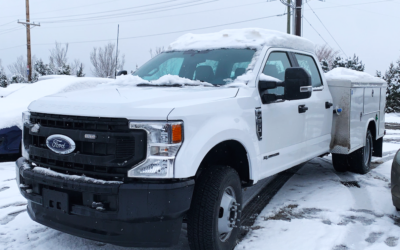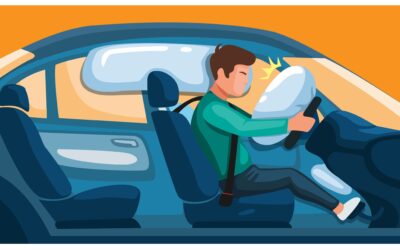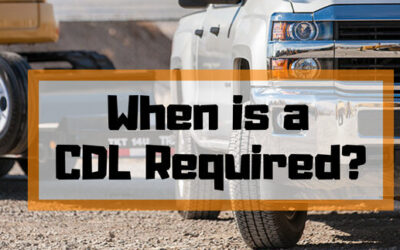When Do You Need a CDL?
What Is A CDL?
A CDL is a commercial driver’s license required by federal law in order to be able to drive and operate certain types of vehicles. CDL license applicants are held to a higher standard and are required to pass specific tests that verify they have the skill and knowledge to operate a vehicle carrying significant weight or transporting 16 or more passengers. There is a CDL weight requirement for the operation of any singular vehicle of 26,001 pounds and over. Read on to learn more about the different CDL classes and their requirements.
Why is it required to get a CDL?
The Commercial Motor Vehicle (CMV) Safety Act of ’86 was passed so that the problem of inadequately qualified vehicle operators could be dealt with. Unqualified drivers had been found to be the major cause of many fatal accidents on the road because they weren’t fully equipped to drive the vehicles they were operating. A lot of the drivers operating vehicles irresponsibly were able to escape accountability for their rash driving by carrying driver’s licenses that had been given to them by different states. This allowed them to spread all of their convictions across the states with no possibility of revoking their licenses (or even suspending them).
Since the CMV Safety Act of 1986, the Federal Government in the United States requires drivers to have a commercial driver’s license in order to be able to drive particular types of commercial vehicles. These licenses are more commonly referred to as CDLs and these CDLs happen to have different classifications.
Types of CDL Vehicle Requirements and When Each is Required
There are three different kinds of CDL vehicle requirements, which are reflected by different CDL classes. The classification of the CDL determines which kind of vehicle a commercial driver can operate. The three classes of CDL required by commercial drivers are:
- Class A
- Class B
- Class C
Among other factors, the classifications for the CDL required by drivers to operate commercial motor vehicles are differentiated by the gross vehicle weight rating or the GCWR of the vehicle. If you’re a commercial driver looking to apply for a CDL, you need to remember that the classification doesn’t only matter when it comes to the motor vehicle you will be operating, it also affects the endorsements you may need to acquire.
To better grasp when a CDL is required, let’s take a look at the different classifications of CDLs.
Class A CDL
A Class A CDL is necessary for the driver to have when he or she is operating a commercial motor vehicle that has a GVWR or gross combination weight rating of 26,001 pounds or more. This includes drivers operating any number of vehicles with a GCWR of 26,001 pounds and a vehicle they might be towing that weighs more than 10,000 pounds.
What you’re allowed to tow when you have a Class A CDL has a lot to do with the endorsements you’ve obtained but here are a few vehicles you can operate when a Class A CDL is required.
- Tanker vehicles
- Truck/trailer combinations
- Tractor-trailers
- Tractor-trailer buses
- Flatbed trucks
- Livestock carriers
A Class A CDL (if you’ve obtained the right endorsements) can also enable you to drive some vehicles that come under the classifications of both Class B and Class C vehicles.
Class B CDL
A Class B CDL is required if a commercial vehicle driver is operating a single vehicle that has a GCWR of 26,001 pounds or heavier. This CDL is required also when a driver is operating a vehicle that is towing another vehicle up to, but not more than 10,000 pounds.
Just like when you have the Class A CDL, you’ll need to have certain endorsements that determine the kinds of vehicles you are allowed to operate with a Class B CDL. Some of them, with the right endorsements, include:
- Box trucks like couriers, delivery trucks, furniture delivery
- Dump trucks that have a small trailer compartment
- Large buses like city buses or school buses
- Segmented buses
- Straight trucks
If you have the right endorsements, the CDL required to operate Class B vehicles can allow you to operate some Class C vehicles.
Class C CDL
This is the CDL required by drivers operating Class C vehicles. When the commercial vehicle the driver must operate does not meet the requirements of Class A or Class B vehicles, they’re required to obtain a Class C CDL. Additionally, the vehicle needs to transport at least 16 passengers (including the driver), or it has to be carrying hazardous material.
The vehicles you are allowed to operate with a Class C CDL, if you have the right endorsements for them, are:
- Combination vehicles that aren’t either Class A or Class B
- Passenger vans
- Small HAZMAT motor vehicles
Endorsements & Restrictions
In addition to CDLs, having the proper endorsements are an important factor regarding the kind of vehicles a driver can operate. There are also restrictions that can be put into place that don’t allow drivers to operate certain commercial motor vehicles.
Endorsements
The drivers who operate special kinds of commercial motor vehicles are required to pass tests and have these endorsements placed on their CDLs.
| Endorsement Code | Description |
| T | Knowledge Test Double/Triple Trailers |
| P | Knowledge Test Passenger |
| N | Knowledge Test Tank Vehicle |
| H | Knowledge Test Hazardous Vehicles |
| X | Knowledge Test Combination of Tank and Hazardous Materials Vehicles |
| S | Knowledge and Skills Test School Bus |
Restrictions
Drivers who are unable to meet certain requirements have certain restrictions placed on their CDLs which prohibit them from driving certain vehicles.
| Restriction Code | Description |
| L | Failure to pass Air Brake Knowledge Test, cannot properly identify air brake system components, doesn’t do a proper system check for air brakes, doesn’t take a skills test, or doesn’t drive a vehicle with a full air brake system. |
| Z | Takes tests in vehicles that have an air-over hydraulic brake system. |
| E | The driver takes the Skills Test in a vehicle that has auto transmission. |
| O | Takes test in Class A vehicle that has a pintle hook or some other non-fifth wheel connection. |
| M | The driver has CDL Class A but has a bus endorsement in a Class B vehicle. |
| N | The driver has Class B CDL but gets a bus endorsement in a Class C vehicle. |
| V | If medical variance has been issued to the driver and the FMCSA has been notified, the information of the medical variance on the CDLIS (Commercial Driver’s License Information System) is made apparent by this. |
Understanding the importance of a CDL for commercial truck driving is important for the safety of yourself and others. Want to learn more about renting a truck for your next job? Make sure you have the proper CDL and visit us here to learn more.
Sources:
https://www.truckingtruth.com/cdl-training-program/page1/who-is-required-to-get-a-cdl
https://www.fmcsa.dot.gov/registration/commercial-drivers-license/drivers
https://www.dmv.org/commercial-drivers/cdl-class-types.php






